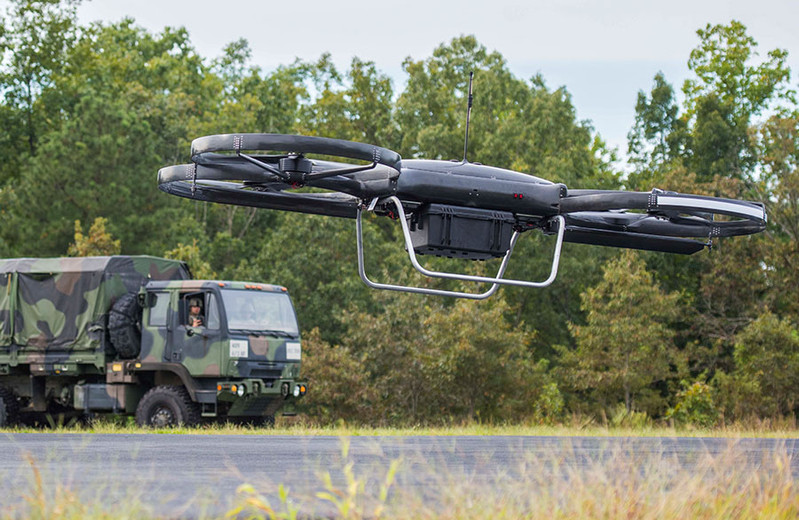SWaP-C2 Optimized UAS Payloads

A wide variety of industries have begun deploying Unmanned Aerial Systems (UASs) on a massive scale. The International Trade Administration of the US Department of Commerce provides a good general definition of UAS:
A UAS generally consists of 1) an aircraft with no pilot on board, 2) a remote pilot station, 3) a command-and-control link, and 4) a payload specific to the intended application/operation, which often includes specialized cameras or other sensors that collect data for near term analysis.
The term payload is referenced frequently when discussing unmanned aerial systems (UASs). Payload refers to the weight that an aerial system can carry, outside of the weight of the UAS itself. The term payload, however, does not refer exclusively to munitions or ordinance. There are a wide variety of sensors, instruments, and cameras that fall within the payload.
Sensor payload examples:
- Thermal cameras have revolutionized surveillance, inspection, and monitoring tasks across various industries. Thermal cameras capture heat emitted by objects and present a view based on temperature differences, allowing operations in complete darkness, through smoke, fog, or in other visibility-limiting conditions.
- Lidar sensors/cameras utilize pulsed laser light to measure distances and to create detailed three-dimensional images of terrain or objects.
- Hyperspectral imaging sensors collect and process information across the electromagnetic spectrum (from visible light to infrared) to obtain the spectrum for each pixel in an image.
- Radar systems emit radio waves that bounce off objects or terrain and return to the radar antenna. Measuring the amount of time it takes for the radio waves to return to the sensor provides info about the speed and location of the targeted object or terrain.
- A wide variety of unique and/or purpose-built sensors are also employed by UASs.
SWaP-C2 Tradeoffs and UAS Efficiency
As unmanned aerial systems – and their payloads – become more complex, they require more processing power and often include data communications networking hardware. Ultimately, the range and capability of these platforms are limited by the size and weight; fuel costs increase as the size and weight of the UAS and payload increase.
Military UAS platforms provide a good illustration of SWaP-C2 (Size, Weight, Power, Cost, and Cooling) requirements and the tradeoffs. In general, UASs can be thought of as remotely or autonomously controlled sensor platforms for information gathering or surveillance. As the information-gathering payloads become more complex, they require more processing power, necessitating more or larger computing components and more power, adding more weight to the platform. Ultimately, the range and capability of these platforms are limited by size and weight. As the weight of the UAS increases, so does the fuel cost.
This tradeoff between the payload and the range of a UAS is quite similar to that faced by spacecraft. While by no means a direct comparison, the “tyranny of the rocket equation,” provides an apt illustration. In a rocket, if the mass of the payload is increased – even minimally – it requires a significant increase in the amount of propellant needed to get to space. The increase in propellant adds more mass, which in turn increases the amount of fuel needed to lift the rocket, creating an untenable feedback loop.
While the interplay between weight and fuel costs in atmospheric UASs is not subject to the razor-thin margins of the rocket equation, the same constraints apply. Therefore, to make the most efficient use of a UAV, the payload – in addition to the UAS itself – must be SWaP-C2 optimized.
Optimizing SWaP-C2 Sensor Payloads
Taking everything above into consideration, designers and manufacturers must optimize sensor payloads for SWaP-C2. This can be a challenging task, often requiring an outside-the-box approach. Sealevel’s work with a hyperspectral imaging system manufacturer provides a great illustration.
Among the hyperspectral solutions offered by the manufacturer is a system purpose-built for unmanned aerial vehicles (UAVs). Its use on UAS platforms makes the system particularly susceptible to SWaP-C2 constraints, as well as extreme vibration and shock tolerance. After performing a detailed analysis of the mechanical and environmental requirements, the Sealevel team specified a COM Express architecture. Due to the unique enclosure of the end product and expansive I/O, Sealevel ultimately proceeded with the development of a unique two-carrier board solution.
Optimizing SWaP-C2 is a balancing act, requiring careful consideration of all parts and individual components. Often, seemingly minor design changes can affect a device or system’s performance. In UAS applications specifically, SWaP-C2 must be managed and optimized to improve operational efficiency and logistics, increase mission life, and reduce the total cost of system ownership.
Categories:
